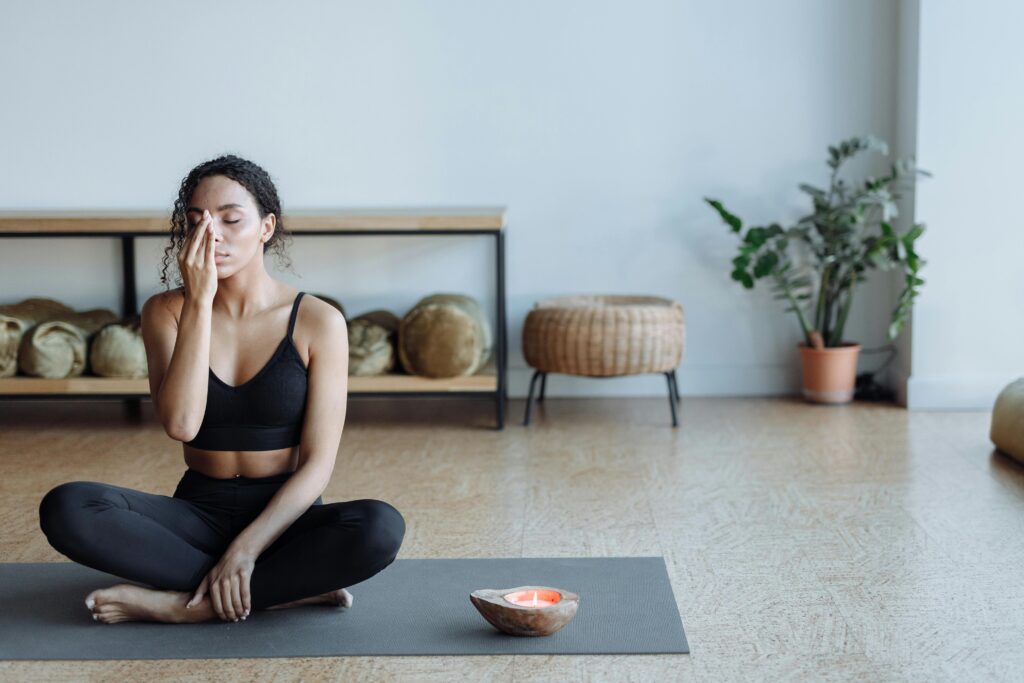Stress is an unavoidable part of life, and there’s no escaping it. From work deadlines to personal responsibilities, daily pressures can pile up fast. And when the stress sticks around for too long, it does not just mess with your mood. It can snowball into anxiety, sleep problems, high blood pressure, and even a weaker immune system.
The good news? You can fight back.
Stress meditation is one of the simplest and most powerful ways to calm your mind, lower stress hormones like cortisol, and build real mental resilience.
It is a little different from regular meditation because it focuses on managing stress specifically, not just mindfulness or spirituality.
And when you pair meditation with regular exercise? You create a total mind-body stress shield.
Understanding How Stress Meditation Helps Mental Health
Stress meditation is all about giving your brain and body a reset.
Instead of letting stress hijack your day (and your health), meditation teaches you how to pause, breathe, and rebalance.
Unlike traditional meditation practices that focus on spiritual growth or mindfulness alone, stress meditation is specifically designed to counteract the effects of stress on the mind and body.
Research consistently shows that meditation can lower cortisol, the primary hormone involved in the body’s stress response. A meta-analysis on meditation interventions found that meditation significantly reduced cortisol levels, particularly among individuals facing higher stress or health changes.
Beyond lowering stress hormones, mindfulness meditation also appears to create positive changes in the brain itself. According to the American Psychological Association, mindfulness-based therapies have been shown to enhance both mental and physical health outcomes.
In other words, stress meditation is not just a temporary coping tool. It helps rewire your mind and body for greater resilience over time.
5 Ways Stress Meditation Strengthens Your Mental Health
Meditation is not a magic wand, but the benefits are real and deeply transformational when practiced consistently.
1. Reduces Anxiety and Depression
One of the most significant benefits of meditation for stress relief is its ability to reduce anxiety and depression. Stress and anxiety often stem from overthinking, negative thought patterns, and excessive worrying about the past or future. Anxiety meditation practices help individuals focus on the present moment, reducing rumination and promoting inner peace.
A study by Johns Hopkins University analyzed nearly 19,000 meditation studies and found that mindfulness meditation programs can lead to moderate improvements in anxiety and depression symptoms.
2. Enhances Relaxation and Emotional Regulation
Chronic stress can make it difficult to relax, leading to muscle tension, irritability, and difficulty concentrating. Stress meditation activates the parasympathetic nervous system, which is responsible for the body’s rest-and-digest response.
By practicing relaxation techniques, individuals can develop better emotional regulation and resilience against stressful situations. Regular meditation helps people respond to stress more calmly, reducing emotional reactivity and improving problem-solving skills.
3. Improves Focus and Mental Clarity
Stress can cloud judgment, impair cognitive function, and make it challenging to focus. Meditation trains the brain to remain present and focused, enhancing cognitive function and mental clarity.
A study from the University of California found that just two weeks of meditation practice led to significant improvements in working memory and cognitive performance.
4. Supports Better Sleep
Stress often disrupts sleep patterns, leading to insomnia and restlessness.
Meditation promotes relaxation, making it easier to fall asleep and achieve deeper, more restorative sleep cycles.
Improved sleep quality further contributes to overall mental health and resilience against stress.
5. Lowers Physical Symptoms of Stress
Chronic stress manifests physically through symptoms like increased heart rate and elevated blood pressure.
Regular meditation has been shown to reduce these physical markers, promoting overall well-being.
By lowering stress hormone levels, meditation contributes to a healthier cardiovascular system.
Effective Meditation Techniques for Stress Relief
There are several meditation techniques that can help reduce stress. Below are some of the most effective methods:
- Mindfulness Meditation: Encourages present-moment awareness, allowing individuals to observe thoughts without judgment. This helps break negative thought patterns and reduces stress.
- Guided Meditation: Uses audio, video, or meditation apps for step-by-step relaxation guidance.
- Breathing Techniques: Deep breathing exercises, such as diaphragmatic breathing, help regulate the nervous system and promote calmness.
- Body Scan Meditation: Involves mentally scanning the body to release tension and promote relaxation.
- Loving-Kindness Meditation: Focuses on generating compassion for oneself and others, reducing emotional distress.
How to Incorporate Stress Meditation into Daily Life
Integrating stress meditation into daily life doesn’t require major lifestyle changes. It simply requires consistency and a willingness to practice. By making meditation a habit, you can gradually train your mind to manage stress more effectively. Below are key strategies to help you build a meditation routine that fits seamlessly into your daily schedule.
1. Start Small and Build Gradually
- If you’re new to meditation, begin with 5-10 minutes daily.
- Choose a time that works best for you, whether it’s in the morning before work, during lunch breaks, or at night before bed.
- As you get more comfortable with the practice, gradually increase the duration to 15-30 minutes per session.
- If sitting still for long periods is difficult, start with short guided meditations to help ease into the practice.
Tip: Even a few minutes of meditation can make a difference. The key is to remain consistent!
2. Choose a Comfortable Space
- Find a quiet, peaceful environment where you won’t be easily distracted.
- A dedicated meditation space at home, such as a corner with a cushion, dim lighting, and calming decor, can enhance relaxation.
- If you live in a noisy environment, consider using noise-cancelling headphones or playing soft instrumental music to block distractions.
- Experiment with different meditation postures, sitting cross-legged, lying down, or even walking meditation, to find what feels most comfortable.
Tip: The space doesn’t have to be large or elaborate; it just needs to be a place where you feel at ease.
3. Set a Routine and Stick to It
- Try meditating at the same time every day to build a habit.
- Morning meditation can set a calm tone for the day, while evening meditation can help unwind and de-stress before bedtime.
- To make it easier to remember, attach meditation to an existing habit, such as right after brushing your teeth or before drinking coffee.
- Use reminders or calendar alerts on your phone to stay on track.
Tip: A consistent schedule makes meditation feel like a natural part of your day rather than an added task.
4. Use Meditation Apps for Guidance
If you’re unsure how to start, guided meditation apps can help. These apps provide structured programs, timed sessions, and voice guidance to keep you focused. Some great options include:
- Headspace: Beginner-friendly with simple, structured meditation courses.
- Calm: Offers a variety of guided meditations, sleep stories, and breathing exercises.
- Insight Timer: Provides thousands of free guided meditations and ambient sounds.
- Simple Habit: Features bite-sized meditations for people with busy schedules.
Tip: Experiment with different apps to find one that best suits your style and preference.
5. Focus on the Breath to Stay Present
- A simple and effective meditation technique is to focus on your breath.
- Try deep diaphragmatic breathing, inhaling through the nose for four seconds, holding for four seconds, and exhaling slowly through the mouth.
- Whenever your mind wanders, gently bring your focus back to the rhythm of your breath.
- Counting your breaths or silently saying “inhale” and “exhale” can help maintain focus.
Tip: Breathing meditation is a great technique for beginners as it provides an anchor for the mind.
6. Experiment with Different Meditation Styles
Not all meditation techniques work the same for everyone. Try different styles to see which suits you best:
- Mindfulness Meditation: Observing thoughts without judgment and staying present.
- Guided Visualization: Using imagery to create a mental escape from stress.
- Body Scan Meditation: Scanning each part of the body for tension and releasing it.
- Mantra Meditation: Repeating calming phrases like “I am at peace.”
- Walking Meditation: Focusing on the sensation of movement and breathing.
Tip: If sitting still is difficult, walking meditation or guided visualization might be a good alternative.
7. Practice Self-Compassion and Patience
- Meditation is a skill that improves over time; it’s normal for the mind to wander.
- Instead of feeling frustrated, gently bring your focus back without judgment.
- Don’t expect immediate results. Meditation works gradually, leading to subtle but powerful changes in stress levels and emotional resilience.
- Treat meditation as a form of self-care rather than a task on your to-do list.
Tip: Progress in meditation isn’t measured by how long you meditate but by how much you benefit from it.
8. Combine Meditation with Other Stress-Relief Activities
- Pair meditation with deep breathing exercises, yoga, or journaling to enhance relaxation.
- Spend a few minutes meditating before or after a workout to boost focus and mindfulness.
- Use aromatherapy, such as lavender or chamomile essential oils, to create a soothing atmosphere.
- Consider listening to calming music or nature sounds during meditation for added relaxation.
Tip: Meditation works best when it complements a balanced lifestyle that includes proper sleep, nutrition, and exercise.
Role of Physical Exercise in Stress Management
While meditation is a powerful tool for managing stress, regular physical activity is equally important. Exercise helps the body release endorphins, which are natural mood boosters that reduce stress and improve emotional resilience. Exercise helps:
- Lower stress hormones: Physical activity reduces cortisol and adrenaline, two stress-related hormones.
- Enhance mood: Exercise increases serotonin and dopamine levels, promoting emotional well-being.
- Improve sleep: Regular workouts help regulate sleep patterns, leading to better rest.
- Boost self-confidence: Achieving fitness goals can enhance self-esteem and reduce stress.
You don’t even need hardcore workouts. 30 minutes of moderate exercise a day can make a significant difference.
- Yoga: Combines meditation, breathing exercises, and movement to promote relaxation.
- Walking or running: Releases tension and helps clear the mind.
- Strength training: Helps channel stress into a productive physical activity.
- Swimming: The rhythmic motion of swimming promotes a meditative state.
Combining meditation with exercise provides a holistic approach to stress relief, addressing both mental and physical well-being.
Final Takeaway
Stress meditation is an effective way to manage mental health. It offers benefits such as reduced anxiety, enhanced relaxation, improved focus, better sleep, and lower physical symptoms of stress.
Individuals can improve their emotional resilience and overall well-being by incorporating various meditation techniques for stress relief.
However, meditation alone is not the only solution. Exercise is equally crucial in maintaining a balanced and stress-free life. Regular physical activity complements meditation by reducing stress hormones and boosting mood-enhancing chemicals.
Combining meditation, relaxation techniques, and exercise can provide long-term mental and physical health benefits for those looking to manage stress effectively.


